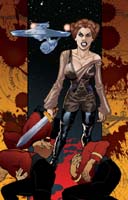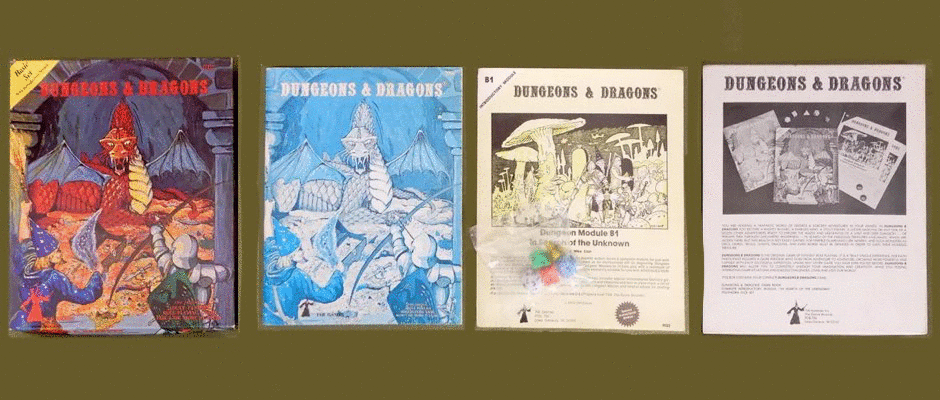 Is this more Klingon revisionism or a wounded franchise trying to cash in? This miniseries from Star Trek’s current comic publisher is partially guilty of having both cynical elements but thankfully the strong writing outweighs what could be dismissed as Klingon spin.
Is this more Klingon revisionism or a wounded franchise trying to cash in? This miniseries from Star Trek’s current comic publisher is partially guilty of having both cynical elements but thankfully the strong writing outweighs what could be dismissed as Klingon spin.
Set after the explosion on Praxis (Star Trek VI), Chancellor Gorkon has the radical notion of the Empire finally ending its ongoing hostilities with the Federation, making peace and asking for their assistance. The High Council is divided evenly so the deciding vote lies with Kanrah, an aging Klingon with “hybrid” features. Everything depends upon him as he explains recent events to his granddaughter K’ahlynn. In his opinion, the humans who lead the Federation have proven to be worthy opponents. The Klingons being defeated by the humans (namely through Captain Kirk) was through their own failings and for underestimating this inferior species as he prefaces the first four issues’ with flashbacks of familiar episodes. Number one tells their side of “Errand of Mercy” with the destruction of the Vortha by the Enterprise and Kor’s occupation of Organia. Unhappy with the terms being imposed upon them by the omnipotent Organians, the Klingons try their hand at espionage through Gralmek in issue two (“The Trouble with Tribbles”). Due to Gralmek’s failure and Koloth’s vessel being filled with the pesky tribbles, the Klingons give up on infiltration, guile and spying. They resort to initiating a proxy war in issue three by arming the villagers of Neural (“A Private Little War”). All fans know, the Federation counters this by arming the hill people with equivalent weaponry and not escalating the conflict. This frustrates the Klingons for they can’t do anything further without violating the treaty and attracting the Organian’s wrath. With issue four, Kanrah introduces K’ahlynn to Morglar, one of the 40 survivors from the Voh’tahk commanded by Kang (“Day of the Dove). Morglar explains how he believed humans were puny, cowardly and all looked alike (he was partially correct if you’re familiar with the episode) until he faced them in personal combat on the Enterprise. Despite everybody being manipulated by the hateful alien energy creature, humans earned a great deal of Morglar’s respect because they fought bravely against terrible odds; Klingons are easily superior in hand-to-hand fighting. In issue five, Kanrah must survive the Klingon side of the conspiracy to cast his vote in favor of Gorkon’s proposal. Everyone knows what happens after that.
There is some retconning with cameos of Dr. Phlox and Captain Sisko as there’s a quick explanation about why Kanrah, K’ahlynn and other famous Klingons lack the boney ridges on their heads like Worf, Chang, Gowron, etc. have. It’s a trivial point but supposedly the “augmented” Klingons dominate the government and military, so much of what’s ugly in the Klingon psyche is this group’s fault. Doesn’t matter in the end, it’s a comic book and carries as much weight as the novels when it comes to continuity. It does share some of ST:NG’s annoying revisionism on past Klingon behavior. For example, when Kor had 200 Organians executed, he did this reluctantly but followed through because he was ordered to. As if Kor was some honorable soldier, not a brutal killer. That defense didn’t hold after of WWII and sadly, it’s a standard tactic by most invaders when their control is tenuous.
The artwork is decent (I can’t draw) yet it is in the exaggerated style of comic books namely with the muscles and female breasts; I don’t think there’s any armor capable of preventing K’ahlynn from having back trouble, even if her uniform uses Wonder Woman physics. I do like how the old-style Klingons are drawn pretty accurately to what they resembled in the Sixties, especially the women. Personally I think the Klingon women were cooler looking when they had hair and hip boots, those sisters from ST:NG always seemed more like comic relief than a dire threat. Main artist David Messina will frustrate many Trekkies as he can’t draw the likenesses of Jon Colicos (Kor), Michael Ansara (Kang), or Bill Campbell (Koloth) let alone Shatner and Nimoy consistently. Not like there’s a lack of reference. Finally, it would’ve been nice if there was some allusion to two other episodes involving the Klingons, “Friday’s Child” and “Elaan of Troyius.” The former would’ve been great since the nameless Klingon was a major element of the story.
Overall, I’m glad I scored this miniseries from my local store (Rogues Gallery) and I look forward to loaning them out to friends who are Star Trek fans of any degree. It was as satisfying as some of the better novels by John Ford, Peter David and James Blish. Now to wait and see what the overrated J. J. Abrams does with Star Trek XI.
